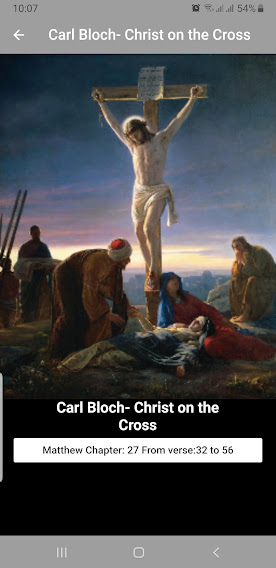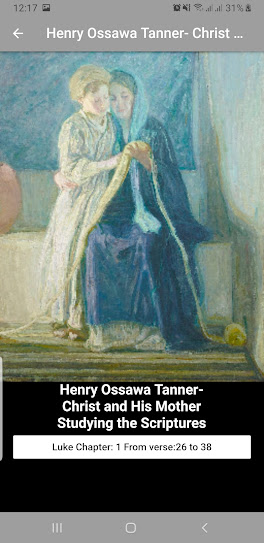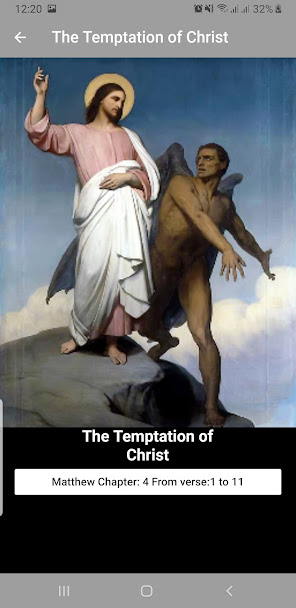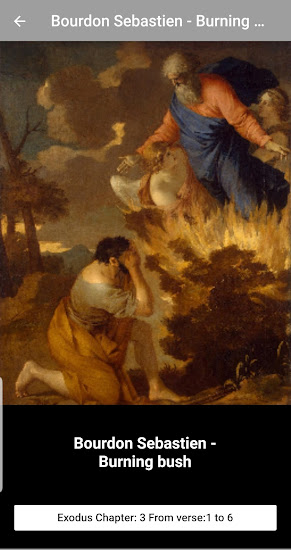We have programmed classical music and a slideshow within the app, to make the viewing of our app more memorable.
We have taken the liberty of expounding on some of the paintings
We have taken the liberty of expounding on some of the paintings
1. The Transfiguration Mark 9:2-13
The Transfiguration is described in the Gospels of Matthew, Mark, and Luke. According to these accounts, Jesus took three of his disciples, Peter, James, and John, to a high mountain where he was transfigured before their eyes. His clothes became dazzling white, and his face shone like the sun. Then, two figures appeared and stood with Jesus: Elijah, who was considered the greatest prophet of the Old Testament, and Moses, who led the Israelites out of slavery in Egypt and received the Ten Commandments. The disciples heard a voice from a cloud saying, "This is my Son, whom I love; with whom I am well pleased. Listen to him!"
1. The Transfiguration Mark 9:2-13
The Transfiguration is described in the Gospels of Matthew, Mark, and Luke. According to these accounts, Jesus took three of his disciples, Peter, James, and John, to a high mountain where he was transfigured before their eyes. His clothes became dazzling white, and his face shone like the sun. Then, two figures appeared and stood with Jesus: Elijah, who was considered the greatest prophet of the Old Testament, and Moses, who led the Israelites out of slavery in Egypt and received the Ten Commandments. The disciples heard a voice from a cloud saying, "This is my Son, whom I love; with whom I am well pleased. Listen to him!"
The Transfiguration is significant for several reasons. Firstly, it is seen as a confirmation of His divine nature. The appearance of Elijah and Moses with Jesus, as well as the voice from heaven, affirmed Jesus' status as the Messiah and the Son of God. Secondly, the event is seen as a foreshadowing of the coming crucifixion and resurrection. The dazzling white clothes and shining face of Jesus are interpreted as a preview of his future glory. Finally, the Transfiguration is considered a moment of transformation for the disciples, who were given a glimpse of Jesus' true identity and were called to listen to him.
The Transfiguration is an important event. It is commemorated on the Sunday before the beginning of the season of Lent and is considered a powerful reminder of the divine nature and mission.
The transfiguration marks the end of an era and the beginning of another, namely the end of the Law (represented by Moses, who appears in the vision) and the Prophets represented by the greatest prophet Elijah (who never died but was assumed into heaven and also was part of the transfigured vision). Both the prophets and the law are to be replaced by the central figure in the revelation, our Savior, who came to both reaffirm and clarify the law.
In questions regarding the Baptist, Christ stated quite clearly that the Baptist was an incarnation of Elijah.
2. Bloch Agony In the garden of Gethsemane Matthew 25:36-46
This depicts a scene before the arrest, trial, and subsequent crucifixion. He spent a few hours in this garden praying over what was to come. In the garden were his favourite apostles (Peter, James, and John), all unfortunately fast asleep.
The passion of Christ started in the garden, for it was from here that Judas brought the temple guards to arrest Jesus upon the instructions of the High Priest Caiaphas.
In the gospels, He went to the Garden of Gethsemane with his disciples to pray the night before his crucifixion. He was deeply distressed and asked the Father if there was any other way to fulfil His plan for humanity's salvation. He said, "My soul is overwhelmed with sorrow to the point of death."
He then asked his disciples to stay and keep watch with him while he prayed. However, they fell asleep. When they awoke, He was deeply distressed and in agony, sweating blood. He went away a second time and prayed, "Father, if you are willing, take this cup from me; yet not my will, but yours be done."
The account of the agony in the Garden of Gethsemane is seen as a pivotal moment, demonstrating his deep commitment to God's plan and his willingness to suffer and sacrifice himself for the salvation of humanity.
This defines the moment upon which the church is founded followed by the resurrection of Christ. Based on Church teachings, the crucifixion was a necessary event for the redemption of mankind. In Jewish temple custom, animal sacrifice was required as atonement for sin. After the crucifixion, this was no longer necessary as His death was sufficient expiation for all men's sins and for all time.
The crucifixion is a central event in our faith and is seen as the culmination of Jesus' life and ministry. We believe that He came to earth to live a sinless life and to offer Himself as a sacrifice for the sins of all people. The Bible teaches that all people have sinned and fallen short of God's perfect standard of righteousness and that the punishment for sin is death. However, God, in His love and mercy, provided a way for people to be forgiven and reconciled to Him through death on the cross.
We believe that He took upon himself the penalty for humanity's sin and that his death satisfied God's justice and paid the price for their forgiveness. Through his death, Christ is seen as having made it possible for people to have the right relationship with God and to receive eternal life.
He went to the cross willingly, despite his distress in the Garden of Gethsemane, and trusted in God's plan for salvation. His death and resurrection are seen as the ultimate expression of God's love for humanity and His desire to bring them back into a right relationship with Him. In addition to its role in the plan of salvation, the crucifixion is also seen as a symbol of hope and triumph over evil and death. We believe that through his death and resurrection, he conquered death and defeated the power of sin and evil. The crucifixion is thus seen as a triumph of good over evil and a source of hope for all people.
In conclusion, the crucifixion is a significant event in our faith, as it is seen as a means of salvation, reconciliation, and hope for all people.
4. Bernhard Plockhorst The parable of the Good Shepherd John 10:1-21
The spiritual analogy is in regards to Israel, and the shepherds of Israel at the time were the Pharisees. They would lead the people astray by not emphasizing the spirit of the law, but rather the letter. The leaders were more concerned about themselves and the accumulation of wealth, rather than shepherding the people.
At the level of the individual, it's true, is it not, that men are generally sheep, going this way and that, following the latest fads or seeking what is terrestrial. The Lord has truly saved me from myself and my self-destructive behaviour. He has made me realize what's important and thus ignore what's not. His teachings as encapsulated in the gospels are truly the teachings of the good shepherd.
In the story, Jesus compares himself to a good shepherd who lays down his life for his sheep. The good shepherd is someone who is invested in the well-being of his flock and is willing to do whatever it takes to protect them. In contrast, the hired hand is someone who is only working for pay and does not have a true relationship with the sheep. When the wolf comes, the hired hand abandons the sheep and runs away, leaving them vulnerable to attack.
The parable also teaches about the importance of following and listening to his voice. Jesus says that his followers should listen to his voice and that through their relationship with him, they will have eternal life. This reinforces the idea that following is not just a matter of religious observance, but a matter of having a personal relationship with him.
In conclusion, the Parable is a powerful and memorable teaching about love and care for his followers. It emphasizes the importance of having a personal relationship with him and following him, and it provides a vivid illustration of the love and sacrifice that Jesus demonstrated through his life and death.
5. Henry Ossawa Tanner Studying the scriptures with his mother Luke 1:26-38
The painter imagines a very likely situation, with the young saviour in religious training. We don't really have much to go on, regarding our saviour as a youth. Some writings were rejected by the church, largely due to the lack of authenticity, namely oral or written traditions. We can only guess how he must have looked and behaved as shown above.
6. Bloch The temptation Matthew 4:1-11
After His baptism and before starting His ministry, our Lord stayed in the wilderness for 40 days and nights and was tested at the tail end of his stay. The church takes this as a model for Lent and Advent, preparing ourselves for his death and resurrection in the former and his birth in the latter.
The account of being tempted by the devil is recorded in the New Testament specifically in the Gospels of Matthew, Mark, and Luke. In these accounts, he is portrayed as being led by the Holy Spirit into the wilderness to be tempted by the devil. The temptation occurred after he was baptized and before he began his public ministry.








